Exploring Street Graffiti: Art, Culture, and Controversy
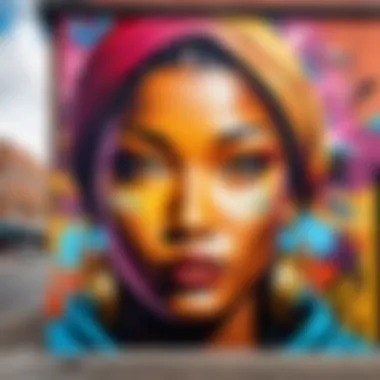
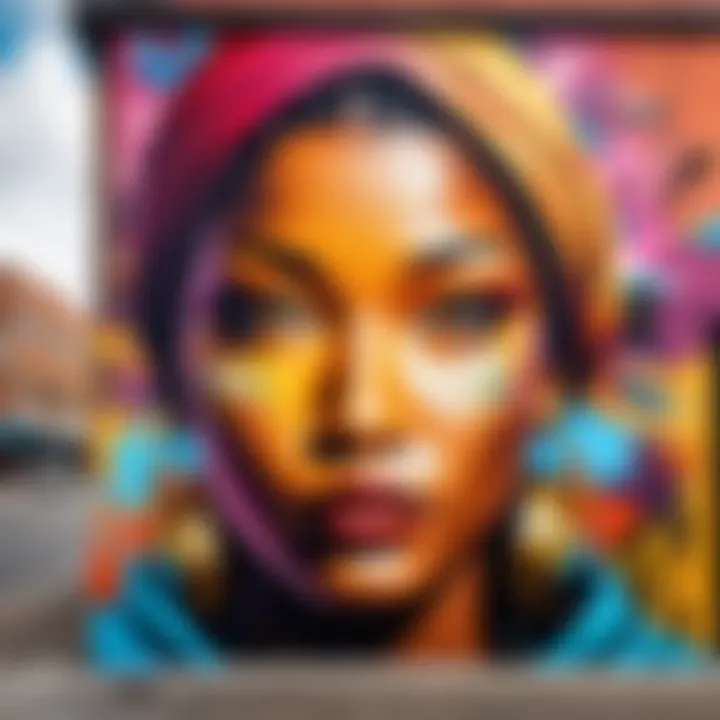
Intro
Street graffiti has transforrmed over decades. Initially viewed as mere vandalism, it now straddles the line between rebellious expression and respected art form. In this exploration, we will investigate how street graffiti has evolved and emerged as a significant aspect of urban culture.
This exploration delves deep into various aspects of street graffiti, especially its relationships with social issues, artistic techniques, and its portrayal of culture. The graffiti artists rank from known figures like Banksy to local taggers, shaping their environments with potent visuals and messages. Understanding graffiti allows for a better appreciation of its value as more than just colorful spray paint on a wall.
Graffiti invites discussion on legality, appropriation of public space, aesthetics, and cultural identity – a territory where art, culture, and controversy intersect. The ensuing sections will bring clarity to graffiti's complexity throughout urban landscapes. Expect insights that sharpen understanding and provide a nuanced lens through which to analyze this public domain.
Preamble to Street Graffiti
Street graffiti represents an important chapter in the story of urban culture and social expression. As society continues to evolve, so does the meaning and acceptance of graffiti as an art form. This section delves into the basic concepts of graffiti, focusing on its definition and origins, as well as outlining its remarkable evolution.
Definition and Origins
Street graffiti can be defined as writing or drawings created on public surfaces, often without permission. It varies widely in terms of style, purpose, and materials. The roots of graffiti trace back to ancient civilizations, where inscriptions were carved in stone or painted on walls. In modern contexts, graffiti began to manifest in cities like New York in the late 1960s and 70s, when young artists began using spray paint to sign their names on trains and walls. This activity cemented graffiti's identity as a form of rebellion and a tool for voice among the urban youth. Its beginnings capture both an artistic urge and a societal need for expression.
Evolution Through Decades
Through the decades, street graffiti has undergone significant transformations. Initially seen as mere vandalism, graffiti gradually gained recognition as a legitimate form of art. During the 1980s, artists like Jean-Michel Basquiat and Keith Haring started integrating graffiti into galleries, bridging the gap between street art and the fine art world. By the 1990s, exhibitions dedicated solely to graffiti art emerged, showcasing notable works from diverse artists around the globe. Today, graffiti serves not merely as a visual statement but as a platform for socio-political commentary. cities continue to witness the flourishing of diverse styles, themes, and messages, a testament to this evolving art form.
Cultural Significance of Street Graffiti
Street graffiti occupies a unique space within the urban landscape, acting as both a rebellious expression and a recognized form of art. Its significance transcends simple aesthetics; it is deeply intertwined with the socio-cultural fabric of communities. While it is seen by some as vandalism, many recognize its potential as a powerful tool for communication and self-expression.
One key element of urban graffiti is its ability to articulate the voices of those marginalized in society. The streets become a canvas for expressing concerns, hopes, and fears where traditional outlets may fail. Grassroots movements utilize graffiti to gather attention and invoke change, contributing to community cohesion and a shared identity. This aspect is particularly notable in urban areas where disenfranchised groups often remain unheard.
Furthermore, street graffiti breathes life into dull wallscapes, often bringing vibrancy to neglected neighborhoods. These visual dialogues prompt spectators to engage, sparking conversations that challenge societal norms and prompt critical thinking. Although frequently dismissed as mere defacement, graffiti embodies the struggles and aspirations of everyday people and can act as a mirror reflecting societal contradictions.
"Street art represents an existential connection between the artist and the beholder. It engages passers-by in thoughts beyond the visual encounter."
Through analysis, it becomes clear that graffiti serves more than a decorative role; it often promotes dialogue on social issues, contributing significant social commentary. Its relevance within contemporary culture cannot be underestimated, especially as cities become centers of creativity and expression. Were it regarded solely as a nuisance, many vibrant contributions to local culture would go unrecognized.
Research indicates that graffiti can progressively shape gentrification processes, as art introduced in disinvested areas attracts media and tourism. But this also raises ethical concerns about the displacement of original community members. Through understanding the cultural significance of graffiti, we can better appreciate its dynamic interactions in urban realms and the complex narratives behind the spray paint on the walls.
Graffiti as a Voice for the Marginalized
Graffiti often becomes a rallying cry for the underrepresented. In various contexts, walls become platforms for community activism. From Native American reservations to inner-city neighborhoods, graffiti allows these groups to preserve their stories and perspectives in a world that often marginalizes their existence. Through slogans and bold imagery, graffiti conveys messages that speak directly to systemic injustices, demanding attention from those in different walks of life.
Artists use unique styles to foster connections within their community. Providing a face for those often ignored, it acts as an agency for social issues like poverty, racism, and inequality.
Political and Social Messages
Throughout history, political protests have utilized graffiti to voice both displeasure and hope. The graffiti culture is intertwined with political unrest. It often serves as a barometer for social sentiments and can incite critical conversations. By employing vivid narratives, artists wield both spray cans and pens, using these as instruments for narrative construction.
Social graffiti responds broadspectrum to current events, expressing sentiments like those seen during political movements such as Black Lives Matter. Or governmental criticism seen in protests across the globe. Though illegal, the function of graffiti as dissent is clear. It provides a space where voices resonate and powerful imagery cannot be ignored. This unique genre of art guarantees permanence where there was once only silence.
Artistic Techniques in Graffiti
Graffiti is not only a platform for expression but also an intricate art form, benefiting from various techniques that artists adopt. Understanding these artistic techniques is essential to appreciate the evolution and significance of graffiti within both urban landscapes and broader culture. Each technique contributes to graffiti's identity as it connects grassroot creativity with urban storytelling. Exploring these techniques provides insight into the flexible nature of graffiti as a medium and its capacity for diverse expression.
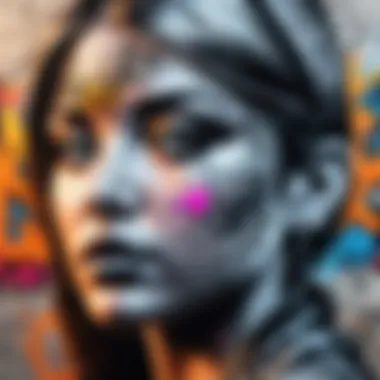
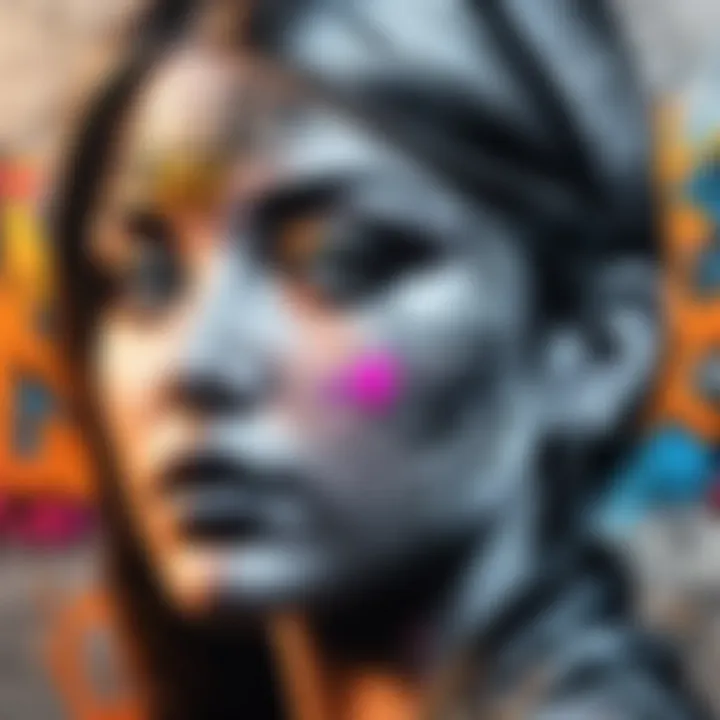
Common Tools and Materials
The tools and materials used in graffiti is vast and unique, shaping the final artwork. Some common tools include:
- Spray Paint: This is arguably the most ubiquitous material in street art. Artists can create wide strokes and fine details with various nozzles.
- Markers: For smaller pieces or for tagging purposes, permanent markers are often used. Different types of markers offer various ink qualities and tip sizes, adapting to specific needs.
- Stencils: Many artists create intricate designs by cutting out shapes in sheets to spray paint over, offering consistent results across different locations.
- Rollers: Used for larger areas, rollers allow for the quick application of colors and something beyond just small tags.
- Brushes: Some artists utilize brushes for finer detail or to blend colors, parallel to canvas painting.
Different surface materials such as brick walls or smooth panels interact with these tools in unique ways, affecting the outcome. Artists frequently combine materials and tools to achieve distinct looks which speaks to their style and message.
Styles and Variations
The style of graffiti varies remarkably, often reflecting the cultural influences and artistic intentions of the creators. Recognized styles of graffiti usually include:
- Tagging: This is the most fundamental level of graffiti, focusing on an artist’s signature. It showcases the name and is often done hastily.
- Throw-ups: More elaborate than tags, these generally feature two or three colors and involve bubble letters for quicker application.
- Wildstyle: A complex and intricate form of graffiti that uses elaborate lettering. Often, letters are intertwined, making it challenging to read, showcasing the artist’s skill and creativity.
- Characters: Incorporating characters can add a story or emotion to the graffiti. They can be cartoons, faces, or designs that reinforce the message or ideology.
- Muralism: Large-scale artworks that tell a narrative or depict broader cultural themes. These require considerable planning and time compared to basic tagging.
Graffiti continues to evolve, with artists blending different styles to establish their unique identities in urban environments. As creativity pushes boundaries, the next generation of graffiti styles surfaces, often aided by new technology and social media.
Graffiti is a language of expressions; its styles tell the stories of artists and their landscapes.
Notable Street Artists
Street graffiti is as much defined by its practitioners as it is by its techniques and themes. Notable street artists have reshaped the perception of graffiti, turning it from mere vandalism into a recognized art form. Their works not only beautify urban landscapes but also convey powerful messages that resonate within socio-political contexts. Exploring the contributions of these artists showcases diverse styles and meanings, allowing a deeper understanding of the ongoing dialogue between street art and societal norms.
Banksy: The Anonymous Visionary
Banksy is often regarded as the quintessential street artist. Emerging from the British graffiti scene, his works are characterized by dark humor and poignant social commentary. Banksy's anonymity creates an intriguing allure, compelling audiences to focus more on the message rather than the identity of the artist.
His pieces often critique political situations, war, and consumerism, encapsulated in simple yet impactful images. One notable work, Girl with a Balloon, has resonated globally, symbolizing hope and loss. Choosing locations strategically, Banksy’s art transforms common spaces into thought-provoking installations. This gives mere walls a voice, sparking discussions on ethics, possibility, and human condition.
Banksy adopts his distinct style using stencils, which allows for precision and speed—key characteristics of urban art. His ability to appeal to the masses has undoubtedly elevated the form, making him a crucial figure in the narrative of street graffiti.
Graffiti in Urban Environments
Street graffiti is not merely an aesthetic proposition; it interacts deeply with urban environments, imbued with the nuances of society and space. Urban landscapes serve as canvases, and the insertion of graffiti alters the convention of these areas. The visual presence of graffiti confronts institutional authority and pushes back against the traditional sanctity of public spaces. It can arise from community-led initiatives or underground movements, illustrating the continuous negotiation between art, expression, and legality. Understanding this dynamic relationship enhances our appreciation of its cultural and artistic value.
Impact of Urban Architecture
Urban architecture markedly shapes graffiti's discourse. The design of buildings, public infrastructure, and shared spaces play a pivotal role in influencing the kind of graffiti that emerges.
- Prominent Spaces: Areas with open walls or well-known locations attract graffiti artists. These spaces become symbols, and their visibility gives context to the messages portrayed.
- Textures and Styles: The materials of urban structures impact artistic choices. Artists adapt their techniques to the textures offered by brick, plaster, or metal. For instance, spraying on a crumbling wall yields a different aesthetic than one of smooth cement.
- Height and Accessibility: The architecture can dictate how accessible a surface is for tagging or artwork placement. Elevated structures may challenge artists but can also inspire creativity through unique approaches.
Furthermore, cities with rich historical contexts, like Paris or Berlin, display graffiti enveloped within their heritage. This interplay enhances the viewer's understanding of both the location and its layer of contemporary societal insights.
Community Spaces and Graffiti
Street graffiti often finds its most potent expression in community areas, encapsulating local cultures and identities. This presence fosters a simultaneous sense of belonging and disruption.
- Local Narratives: Graffiti can amplify the concerns, aspirations, and stories of marginalized groups within communities. By reflecting the inhabitants, a neighborhood's public face reveals deeper social narratives that might otherwise remain unheard.
- Collective Identity: Local artists contribute to shared community identities as urban art symbolizes where residents come from and their struggles or triumphs.
- Opposition and Ownership: These communal spaces can occasionally become battlegrounds for conflicting ideologies; murals might be commissioned to beautify an area while tags from different artists challenge that conception, leading to scenarios that encapsulate feelings of exclusion versus inclusion.
Shielded by the acceptance of community, street graffiti can convert these urban landscapes into platforms for dialogue, making clear its ficative stance within societal upheavals or cultural shifts.
“Graffiti is a social dialogue, shouting for recognition!”
The Controversy Surrounding Street Graffiti
Street graffiti occupies a unique space within contemporary discussions of art and culture. Its duality as both expression and vandalism generates significant debate. Underlying this controversy are many factors, including the legal implications of graffiti, public perception, and the social consequences that stem from its existence. Understanding this topic is essential for grasping the complex nature street graffiti holds in modern society.
Legal Perspectives
Graffiti is often viewed through a legal lens, which varies considerably across different municipalities and nations. In many places, artists face severe penalties for acts perceived as vandalism. The distinction in law is notable between formal graffiti art and illicit tagging. Legal ramifications can range from fines to imprisonment. Some cities have begun to recognize the cultural value of graffiti and created designated areas for street artists to express themselves legally. These sanctioned spaces allow artists to collaborate without fear of prosecution, signaling a shift in perception toward embracing graffiti as a legitimate form of artistic expression.
The criminal nature of graffiti often polarizes opinions. While some argue that it is an act of rebellion and a form of free expression, others see it as a destruction of property that disrupts urban landscapes. Interest in graffiti legality also intersects with discussions on property rights and artistic freedoms. Graphic artists, experience numerous challenges navigating these conflicting perspectives.
Public Perception and Stigmatization
Public acceptance of street graffiti entails various perceptions that further fuel ongoing debates. For some, graffiti symbolizes social upheaval and defiance. For others, it brings to mind images of decay and neglect. The media plays a critical role in shaping these attitudes. A favorable portrayal of street art often contrasts with coverage of tagging activities spelling out crime or disorder.
Communities observing graffiti may exhibit vastly different reactions. In areas where it is deemed part of local culture, people may view it as artistic expression reflecting individual experience or social commentary. Conversely, in neighborhoods where it is stigmatized, it may be seen simply as vandalism. The dialogue between different societal, especially regarding aesthetic appreciation and community values, is particularly salient. Various stakeholders—artists, residents, civic leaders—must navigate a termed space where creating art is caught in a complicated exchange of understanding and misunderstanding.
The relationship between street graffiti and public response reveals the challenges of art in negotiation spaces, contributing to ongoing discourse about ownership, authority, and individual creativity.
The complexities surrounding public perception make it integral to the overall dialogue on graffiti. Limited perception can restrict artistic expression and reinforce negative societal biases that graffiti artists must contend with.
Overall, exploring the controversy of graffiti unveils a greater narrative revealing how art permeates spaces and represents varied interpretations and emotional responses across communities.
The Role of Technology in Graffiti
Technology has become a pivotal aspect of how graffiti is created, shared, and perceived. The integration of digital tools and platforms has transformed artists' approaches, offering improved methods for creativity and expression. Using technology not only enhances artistic output but also changes how graffiti interacts with the public and is viewed culturally. Understanding the role of technology in graffiti provides insights into the future possibilities of this form of expression.
Digital Tools for Graffiti Artists
Digital tools have radically changed the landscape of graffiti art. Today, artists can manipulate design software, utilize GPS technology, and access a plethora of application tools. Some essential tools include:
- Graphic Design Software: Software like Adobe Photoshop and Illustrator allows artists to design and visualize their work on various surfaces before executing them in public spaces.
- Airbrush Effects: Using digital airbrush techniques can produce softer transitions and complex texture effects, creating depth and a unique finish.
- Interactive Apps: Applications, such as Graffiti Creator, have simplified the process of sketching concepts digitally. These apps give artists a space to explore their creativity without purchasing tools used for traditional graffiti and they can even add photorealistic effects to their work.
Moreover, some graffiti artists are employing augmented reality alongside traditional methods. Adjustments made in design through AR applications enable more engaging and dynamic murals, blurring the lines between physical and virtual realms.
Social Media�’s Impact on the Graffiti Scene
Social media has become a vital platform for graffiti artists. It creates spaces for showcasing work, networking, and discussing methods. The following factors illustrate the significant impact of social media on the graffiti scene:
- Increased Exposure: Platforms like Instagram and Facebook provide a way for artists to gain visibility worldwide, allowing them to share their work without limitation to local audiences.
- Community Building: Many graffiti artists foster a sense of community through social media. Groups on Reddit or Facebook connect artists, enabling collaboration and peer feedback, which can enhance artistic development.
- Trend Setting: Social media helps in promoting trends rapidly. What becomes popular in one part of the world can easily spread to others through shares and likes, influencing how graffiti evolved across different cultures.
This interconnectedness created by technology and social media serves not just artists but transforms the public perception of graffiti.”
The rise of hashtag culture and dedicated graffiti accounts has made it easier for artistic talent to emerge, breaking free from underground limitations, thus redefining street art. This transformation means that graffiti is no longer solely accessible to those who
Graffiti: A Global Perspective
Exploring graffiti from a global perspective is essential in understanding its role and influence across diverse cultures. Street graffiti mirrors societal emotions, challenges, and aspirations. Each regional style carries unique nuances, reflecting the vibrancy and climate of specific areas. As an art form, graffiti showcases various artistic expressions, engaging locals and tourists alike.
Street Art Movements Around the World
Different regions have developed their own street art movements that resonate deeply with local culture. In places like Berlin, graffiti often conveys messages of political repression and freedom. Vibrant murals adorn walls, speaking to both the history and socio-political current events. The Berlin Wall, famous for its graffiti, became a canvas for artists expressing their stories when the area underwent major transformations.
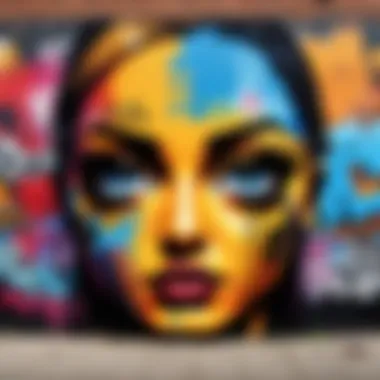
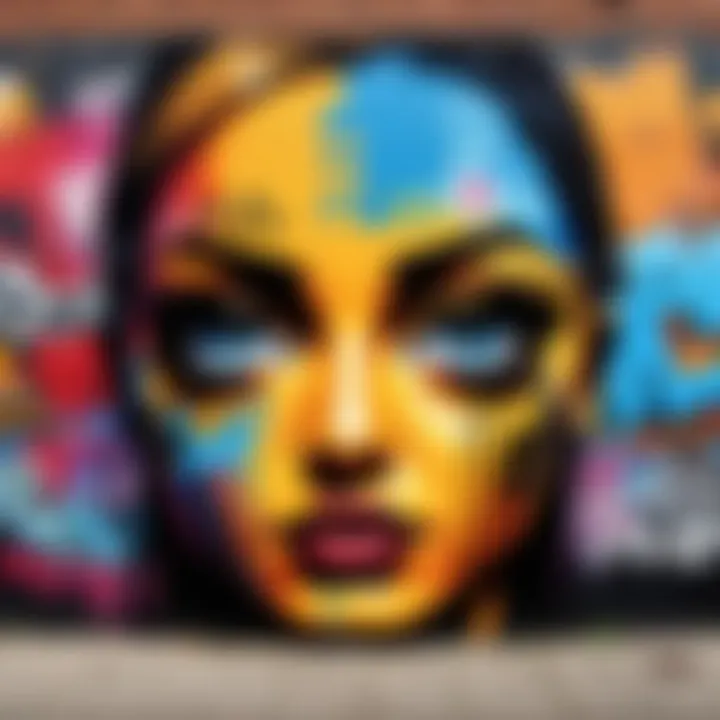
In Brazil, urban art represents the struggle against poverty and urban decay. Artists like Os Gêmeos explore indigenous imagery and Brazilian culture in their vivid installations. In this way, graffiti becomes a voice for those who might otherwise remain unheard.
Notable street art movements also appear in regions such as Melbourne, Australia, and New York City, USA. These cities serve as proving grounds for artists pushing creative boundaries. Melbourne's laneways stand as renowned hotspots for artistry, with local artistry and lawful space showcasing creativity collaboratively.
Cultural Differences in Acceptance
Acceptance of graffiti varies significantly between cultures. In some communities, street art is celebrated as valuable public art. In contrast, in other areas, it is seen as mere vandalism. For example, in Italy, there is a strong tradition of street art, with cities like Rome celebrating artists who invigorate the historic backdrop with colorful creations. Artists work within legal frameworks, turning urban spaces into galleries that attract tourists.
Contradictory to Italy’s attitude, there are places in the United States, such as Los Angeles, where the law can strictly bind graffiti artists. Segregated views exist among locals: while some see vibrancy, others associate graffiti with decline. This division shows how perceptions of graffiti evolve substantially from one cultural context to another.
Cultural attitudes, along with legal ramifications, play crucial roles in determining both the public and governmental reception. By analyzing graffiti from a global lens, one can stand deeper insights into methodologies, philosophies, and societal impacts that shape the art form worldwide.
"Graffiti can be described as an open dialogue between the artist and the beholder, bound together by people's thoughts, emotions, and cultures."
Future Trends in Street Graffiti
Future trends in street graffiti reveal significant changes that artists and communities are embracing. This trend is not just about evolving techniques but also about broader themes of acceptance and technology. Understanding these trends is crucial for grasping graffiti's place within contemporary society. Street graffiti reflects the zeitgeist of current culture, showcasing innovation and shifting attitudes toward public art.
Emerging Styles and Techniques
Emerging styles in graffiti demonstrate a blend of traditional methods with modern influences. Factors like technology and social culture greatly affect these developments. Here are some specific trends worth noting:
- Multi-layer Stenciling: Graffiti artists are using multiple stencil layers to create intricate designs that offer depth and complexity.
- Augmented Reality (AR): Some artists incorporate AR to add a digital layer to their artworks, creating a unique experience for viewers.
- Eco-Friendly Materials: With increasing focus on environmental issues, more artists are selecting sustainable paints and materials for their work.
- Collaborative Projects: Collective murals or art serves as a form of community expression, blending various individual styles into a unified piece.
Graffiti's evolution influences aesthetic preferences and cultural discussions. By keeping an eye on these changes, one observes a continuous reinvention of expression through street art.
Graffiti's Place in Contemporary Art
The notion of graffiti as contemporary art is gaining traction. Traditionally viewed as vandalism, graffiti now finds acceptance in galleries and exhibitions. Various elements contribute to this evolution:
- Institutional Recognition: Art institutions are incorporating graffiti into their exhibitions, allowing artists to gain visibility. Works by Banksy, for instance, have blurred the lines between graffiti and fine art.
- Auctions and Market Growth: Street art's commercial market has grown. Many artworks sell for thousands at auctions, signaling their emerging status within the art economy.
- Cultural Appreciation: Increased globalization leads to more appreciation and understanding of diverse styles, embracing what street artists offer in terms of reflection on urban lives.
Grafitti transcends mere decoration; it offers insight into societal trends, pressing issues, and personal narratives.
Analysts believe that as street art continues to be recognized, its acceptance can reshape not only urban landscapes but also social conversations surrounding ownership, space, and rebellion.
The trends in street graffiti showcase an exciting intersection of art, culture, and technology. As artists challenge perceptions and utilize new themes and techniques, the space will continue to grow—advancing urban art, both in creative capacity and social significance.
Culmination: The Duality of Street Graffiti
Street graffiti evokes a spectrum of values within society. The persistent clash between viewing graffiti as intrinsic art form and regarding it as mere vandalism fuels ongoing discussions concerning urban expression and cultural integrity. Its dual nature reverberates through conversations centered on artistic freedom and public space utility.
The importance of this topic lies in demonstrating how perceptions drive the dynamics of art. Artistic expression presents a legitimate channel for conveying deep emotions, explorations of identity, and social commentaries. As graffiti artists push boundaries, interpretations form varied perspectives of appreciation and disdain.
Artistic Expression vs.
Vandalism
Errors in overlooking the artistic qualities of graffiti often lead to insisting on its classification as vandalism. Graffiti summons power via shared visual language. While some discredit street art as defacing property, others consider it a valid and necessary interpretation of place and time that provides voice to underserved communities.
- The concept of decorum complicates many evaluations about provocative street work. What is considered art in one hemisphere may symbolize chaos in another. Artists face tremendous pressures to reach broader audiences even when city ordinances differ.
- Despite legal profiles varying from city to city, discussions converge on environments that influence street ecology. Many urban spaces see graffiti as reclaiming restricted or forgotten realities. Therein lies an intersection of an underrepresented narratives, catalyzing rich conversations about ownership within the oft-overlooked zones of urban life.
“In dismantling the dichotomy of graffiti, it moves from being categorized into oversimplified imperatives into a dialogue of individuality and transformation.”
Art becomes a performance, thereby encouraging actions demanding awareness and respecting community identity. The complexity builds intrigue around the matter, shaping a culture permeated with distinct responses. Although debate continues about the placement of graffiti within the art spectrum, it remains ever-present reflection about humanity and establishes defiance, dormant thoughts, and raw political expression toward the public domain.
As this article illustrates, street graffiti deserves a greater acknowledgment of its duality. Managing its association with democracy in expression highlighted throughout history emphasizes key change drivers in forthcoming narratives.







